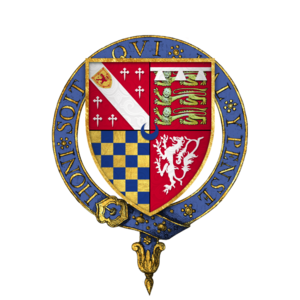Edward Howard (admiral) facts for kids
Sir Edward Howard (born around 1476 or 1477, died April 25, 1513) was a brave English naval officer. He was the first famous admiral from the Howard family. He fought in his first sea battle as a teenager. He led the English fleet during the Battle of Saint-Mathieu. This battle might have been the first to use cannons on ships through special openings. Sir Edward was killed soon after, while attacking French ships near Brest.
Contents
Early Life of Sir Edward Howard
Sir Edward Howard was the son of Thomas Howard. His mother was Elizabeth Tilney. He was also the younger brother of Thomas Howard, 3rd Duke of Norfolk. We don't know much about his childhood or schooling.
First Military Steps
Sir Edward began his military career early. In August 1492, at age fifteen, he fought under Sir Edward Poynings. This was during a siege at a place called Sluys.
In 1497, his father, then the Earl of Surrey, took him and his brother Thomas to Scotland. They were part of a military command there. On September 30, 1497, both Edward and Thomas were made knights. This happened at Ayton Castle. It was after a peace treaty was signed with King James IV.
Serving King Henry VIII
When King Henry VII died in 1509, Henry VIII became the new king. Sir Edward Howard played a big part in the celebration tournament. This event was held for the new King's coronation. On May 20, 1509, he was chosen to be the King's standard-bearer. This meant he carried the royal flag.
Sir Edward Howard became a very important naval leader. He was known for his skills at sea.
Battles and Captures
Between June and August 1511, Sir Edward prepared ships for merchants. During these trips, he and his brother Thomas captured ships. These ships belonged to a Scottish adventurer named Andrew Barton. Barton was a privateer, meaning he had permission to attack Portuguese ships.
Barton's warships, the Lion and the Jennet of Purwyn, were captured. Andrew Barton himself was killed during the fight. His ships were taken to Blackwall.
War with France (1512)
In April 1512, England went to war with France. Sir Edward Howard was made admiral of a fleet of 18 ships. His job was to control the seas between Brest and the Thames River. He stopped many ships, saying they carried French goods.
In early June, he helped escort an English army to Brittany. This army was sent by King Henry VIII to try and take back Guyenne. After this, Howard attacked towns on the Breton coast, like Le Conquet and Crozon.
Controlling the Channel
During June and July 1512, Sir Edward Howard was in charge of the English Channel. It is said he captured over 60 enemy ships. By August, a large French fleet gathered at Brest. Howard attacked them.
This led to the Battle of Saint-Mathieu. During this battle, the two largest ships, the English Regent and the French Marie de la Cordelière, were destroyed. The French ship's gunpowder storage exploded. The French fleet retreated, even though they were not fully defeated.
Becoming Lord High Admiral
On October 10, King Henry VIII rewarded Sir Edward. He gave him money each year and promised him the job of Lord High Admiral. This important role was held by the Earl of Oxford at the time.
Final Battle and Death
In late 1512, the French King brought six galleys (fast, oar-powered ships) from the Mediterranean Sea. By March 1513, a big French fleet was ready. On March 10, 1513, the Earl of Oxford died. Sir Edward Howard then became the Lord High Admiral.
On March 19, he sailed from the Thames. He reached Plymouth on April 5. Without waiting for his supply ships, he sailed from Plymouth. He found the French fleet, which then went back into Brest.
Sir Edward lost one ship on a hidden rock. On April 22, the French galleys attacked him. Their heavy cannons sank another English ship. On April 25, Sir Edward decided to attack the galleys. He used his smaller, faster boats called row-barges.
Sir Edward Howard personally led the attack on the main French galley. During the intense fighting, he was pushed overboard. The heavy weight of his armor caused him to drown. His body and his silver whistle (a symbol of the Lord Admiral's job) were found three days later. They were given to the French commander, who sent the armor as a prize to the French princess. The whistle went to the French Queen.
Aftermath
After Sir Edward's death, the English fleet was sad and low on supplies. They went back to Plymouth. Sir Edward's brother, Thomas, took command. The French could not use this chance to win. After successful English campaigns, a peace agreement was made in March 1514.
Sir Edward Howard had been chosen for the Order of the Garter in 1513. This was a very high honor, but he died before he could officially join.
Family Life
Sir Edward Howard was married to Alice Parker. She was the daughter of William Lovel. Alice was also known as the Baroness Morley. They did not have any children together.



